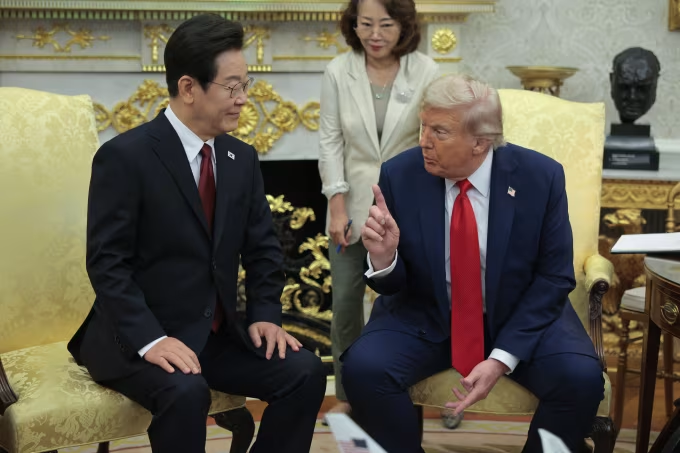United States President, Donald Trump, has expressed readiness to hold talks with North Korean leader Kim Jong Un, following discussions with South Korea’s new president, Lee Jae Myung, on peace efforts in the Korean Peninsula and Pyongyang’s nuclear ambitions.
During his first official visit to the White House on Monday, Lee, who took office in June, appealed to Trump to take on the role of mediator between the two Koreas, insisting that the region had been “more stable” during Trump’s earlier term in office.
“I think you are the first president to have so much interest in the world’s peace issues and actually made achievements,” Lee told Trump. “So, I hope you would make peace on the Korean Peninsula … and meet with Kim Jong Un.”
Lee pledged that he would “actively support” Trump should he decide to “play the peacemaker,” stressing that the U.S. leader was “the only person who can actually solve” the long-standing conflict between Seoul and Pyongyang.
The Korean War of 1950–1953 ended with an armistice but never produced a peace treaty, leaving the two nations technically still at war.
The summit also tested Lee’s ability to navigate South Korea’s critical ties with Washington amid the challenges posed by Trump’s “America First” agenda.
Accompanied by a large delegation of top South Korean CEOs, Lee unveiled major investment commitments in the U.S.
Korean Air announced plans to acquire 103 aircraft from Boeing, alongside engine deals and maintenance programs with GE Aerospace and CFM International, worth $50 billion.
Hyundai Motor Group followed with news that it would raise its U.S. investment from $21 billion to $26 billion. Overall, Lee revealed that South Korean businesses intend to inject about $150 billion into the U.S. economy.
The South Korean leader also offered Trump a selection of personalized gifts, including two cowboy hats embroidered with the “Make America Great Again” slogan, a custom golf putter, and a model of a “turtle ship.” Playing to Trump’s well-known passion for golf, Lee quipped that a Trump Tower should be built in North Korea “so I can go play golf in Pyongyang as well.”
Trump, who has long highlighted his personal diplomacy with both Seoul and Pyongyang as one of the hallmarks of his presidency, responded enthusiastically.
“I will do that, and we’ll have talks. He’d like to meet with me,” Trump said of Kim. “We look forward to meeting with him, and we’ll make relations better. You’ll help that.”
Still, whether such a meeting materializes remains uncertain. Just days before the Trump-Lee summit, North Korea tested two new air defense missiles, and its state media accused the U.S. of plotting to “occupy” the Korean Peninsula through joint military drills with Seoul.
Lee further warned after his meeting with Trump that Pyongyang’s nuclear capacity had grown significantly.
He claimed North Korea could now produce between 10 and 20 nuclear weapons annually, a number “higher than normally assumed” and suggestive of “additional uranium enrichment capacity,” according to Hans Kristensen, director of the Nuclear Information Project at the Federation of American Scientists.
North Korea’s threats have been amplified by closer ties with Moscow, with reports of North Korean troops deployed to support Russia in its war against Ukraine.
This is not the first time Trump has engaged directly with Kim. After a fiery period of missile tests and heated exchanges in 2017 – when Trump dubbed Kim “Little Rocket Man” and warned of “fire and fury like the world has never seen” – the two leaders developed an unlikely rapport. They exchanged what Trump called “love letters,” paving the way for a series of historic meetings in 2018 and 2019.
In a striking moment at the demilitarized zone, Kim even invited Trump to cross into North Korean territory, making him the first sitting U.S. president to do so.
However, subsequent negotiations, including a 2019 summit in Hanoi, collapsed without agreement, and Pyongyang eventually resumed weapons testing.
Since then, Kim has vowed to exponentially expand North Korea’s nuclear arsenal. At a Washington think-tank event, President Lee warned that Pyongyang’s stockpile of nuclear weapons has grown 2.5 times in recent years, and that the regime is nearing completion of intercontinental ballistic missiles capable of hitting “far away distances.”
Meanwhile, U.S. defense officials anticipate further advancements in North Korea’s weapons program. “In the coming year, we expect (North Korea) to further develop hypersonic and multiple, independently targetable reentry vehicle capabilities to complete (their government’s) goals,” testified Army Gen. Xavier T. Brunson before Congress earlier this year.
